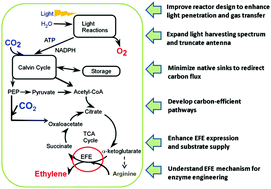Techno-economic analysis of a conceptual biofuel production process from bioethylene produced by photosynthetic recombinant cyanobacteria†
Abstract
Ethylene is a petrochemical produced in large volumes worldwide. It serves as a building block for a wide variety of plastics, textiles, and chemicals, and can be converted into liquid transportation fuels. There is great interest in the development of technologies that produce ethylene from renewable resources, such as biologically derived CO2 and biomass. One of the metabolic pathways used by microbes to produce ethylene is via an ethylene-forming enzyme (EFE). By expressing a bacterial EFE gene in a cyanobacterium, ethylene has been produced through photosynthetic carbon fixation. Here, we present a conceptual design and techno-economic analysis of a process of biofuel production based on the upgradation of ethylene generated by the recombinant cyanobacterium. This analysis focuses on potential near-term to long-term cost projections for the integrated process of renewable fuels derived from ethylene. The cost projections are important in showing the potential of this technology and determining research thrusts needed to reach target goals. The base case for this analysis is a midterm projection using tubular photobioreactors for cyanobacterial growth and ethylene production, cryogenic distillation for ethylene separation and purification, a two-step Ziegler oligomerization process with subsequent hydrotreatment and upgradation for fuel production, and a wastewater treatment process that utilizes anaerobic digestion of cyanobacterial biomass. The minimum fuel selling price (MFSP) for the midterm projection is $15.07 per gallon gasoline equivalent (GGE). Near-term and long-term projections are $28.66 per GGE and $5.36 per GGE, respectively. Single- and multi-point sensitivity analyses are conducted to determine the relative effect that chosen variables could have on the overall costs. This analysis identifies several key variables for improving the overall process economics and outlines strategies to guide future research directions. The productivity of ethylene has the largest effect on cost and is calculated based on a number of variables that are incorporated into this cost model (i.e., quantum requirement, photon transmission efficiency, and the percent of energy going to either ethylene or cyanobacterial biomass production).



 Please wait while we load your content...
Please wait while we load your content...